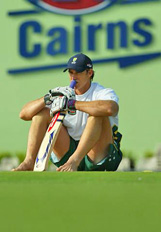ARTICLES
Preparation for a game - Opening the Innings
- By S.P Bhatia
It will be safe to say that cricket is more a mental game than a physical one. Many players who have had some limitations on the technical front have succeeded at the international level due to their mental toughness and temperament. Steve Waugh is an appropriate example in that regard. Mental toughness makes 'great' players out of 'good' players.
Hence, it is necessary to prepare oneself mentally before every match. The preparation can begin by developing a routine before every match or every practice session. This will help develop a positive mind-set. However, this routine should provide for flexibility. Lack of the ability to adapt to changing situations can prevent a player from realizing his fullest potential.
Apart from normal practice, one should include relaxation and 'mental practice' into one's routine. Breathing, the core of yoga, is the best relaxation activity that can be practiced before taking the crease.
Another aspect of preparation is to be aware of the opponents' strategy against you, and to try and 'out-think' them.
Each position in the batting order has its own special mental demands. Of course, the match-situation influences this demand. For opening batsmen as well as tail-enders, there is scope to sharpen their skills by understanding the basic details of the game. Mental toughness and sharpness allow a player to comprehend these details better.
OPENERS
The openers have to perform four different roles depending upon the situation.
- To see through the new ball
- To attack the bowlers when they are worn out
- To support the attacking middle-order batsmen
- To steady the boat if an early wicket falls.
All these roles require different mindset and physical demands.
STARTING AN INNINGS
Hayden, the most prolific opener of the modern era, is one who comes to mind immediately. He not only 'meditates' on the pitch the day before the match, but also follows a ritual during the match, which involves squatting on the pitch after taking guard. Different openers have different methods. Nobody was supposed to talk to Sunil Gavaskar ten minutes before he went in to bat.
The other 'positions' in the batting order will be dealt with in the subsequent article.
Hence, it is necessary to prepare oneself mentally before every match. The preparation can begin by developing a routine before every match or every practice session. This will help develop a positive mind-set. However, this routine should provide for flexibility. Lack of the ability to adapt to changing situations can prevent a player from realizing his fullest potential.
Apart from normal practice, one should include relaxation and 'mental practice' into one's routine. Breathing, the core of yoga, is the best relaxation activity that can be practiced before taking the crease.
Another aspect of preparation is to be aware of the opponents' strategy against you, and to try and 'out-think' them.
Each position in the batting order has its own special mental demands. Of course, the match-situation influences this demand. For opening batsmen as well as tail-enders, there is scope to sharpen their skills by understanding the basic details of the game. Mental toughness and sharpness allow a player to comprehend these details better.
OPENERS

Matthew Hayden 'meditating' on the pitch on the eve of a game.
An opening batsman must be courageous and have the ability to react quickly against fast or medium-pace bowlers. Openers like Sunil Gavaskar and Geoff Boycott were masters in handling the pressures of opening, and adept at building long innings.
The fast bowlers will try to unnerve the openers through physical intimidation with a battery of short-pitched deliveries. Openers must have the courage, resilience, and self-belief to play this type of bowling. They ought to stay composed and try to rotate the strike. This will reduce the bowlers' effectiveness in applying constant pressure.
The openers must aim to play through the entire first session without losing a wicket. This calls for a high level of concentration and the dealing of each delivery on merit. Openers very often receive unplayable deliveries. It is essential that they learn to forget about them and focus on the next delivery.
The openers must aim to play through the entire first session without losing a wicket. This calls for a high level of concentration and the dealing of each delivery on merit. Openers very often receive unplayable deliveries. It is essential that they learn to forget about them and focus on the next delivery.
- To see through the new ball
- To attack the bowlers when they are worn out
- To support the attacking middle-order batsmen
- To steady the boat if an early wicket falls.
All these roles require different mindset and physical demands.
STARTING AN INNINGS

Steve Waugh - one
of the all-time greats.
A batsman is most likely to be dismissed at the very beginning of his innings, when he is new to the crease and hasn't got his eye in. One mistake and he could be cooling his heels in the pavilion. No matter how benign the wicket may be, or mediocre the opposition maybe, there will be some amount of nervousness in the batsman, due to the apprehension of getting out first ball. Here, it is important for the batsman to control his emotions. It is natural and important to feel the adrenalin flowing, but striking a balance is important, which means that although he may be edgy, he should be able to control his movements and thoughts. Routine again plays an important role here. Usually all batsmen, particularly openers, have a routine that they follow unconsciously.